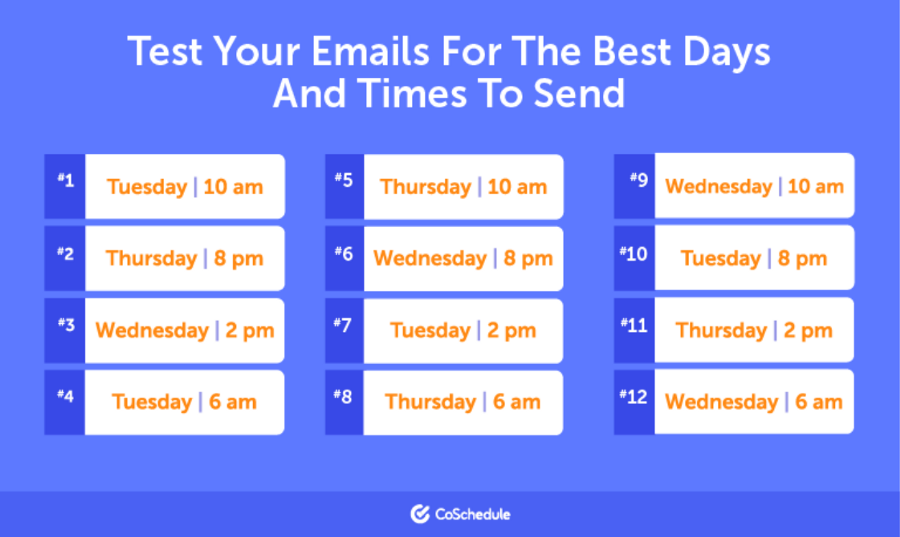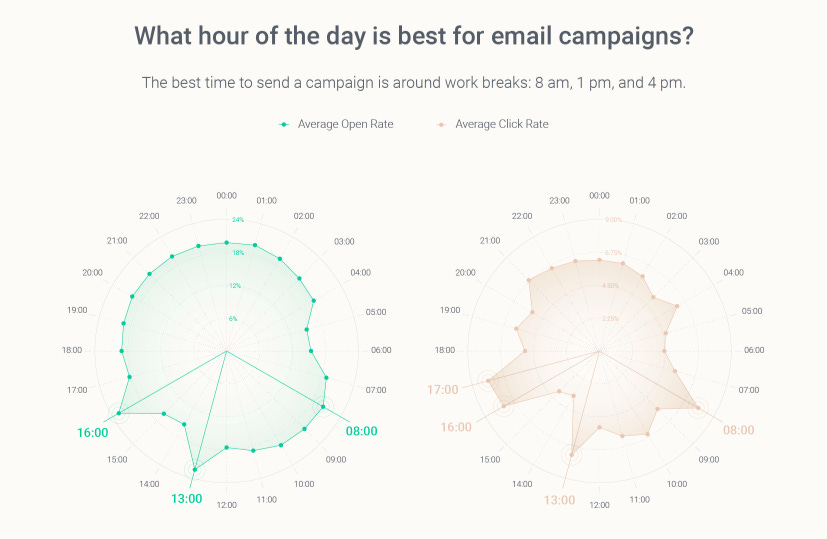💌 The best day and time to send e-mails during COVID-19
Some marketing talk on how to improve your e-mail campaign's open rate or click-through rate (CTR) amidst work from home arrangements during the pandemic.
I was trawling through the web, doing research on the best time to send this newsletter to you, and thought that it’d make sense to share it.
If you’re too busy to read on this morning, simply scroll down to the image under the subheader, ‘📋 Some guidelines’ or simply look at when this e-mail was sent to you. Do bear in mind that there’s no one-size-fits-all answer, and that your target audience’s behaviours and preferences ultimately override all these research.

You may be the author of your own newsletter subscription, a marketer of an ecommerce site aiming to sell various products through daily and/or weekly EDMs, or just a curious e-mail sender trying to understand the behaviour of fellow e-mail users.
Regardless of who you are, this article will guide you into determining the best day and time to send out e-mails.
It’ll also suggest an exact day and time at the end of the article, so stay tuned!
🤔 Questions to ask yourself
There are so many factors involved when deciding what time to blast that EDM out to your e-mail list. You should ask yourself an onslaught of questions to figure out how to to improve your e-mail open rate.
The questions can look a little like this:
What is the nature of the content that you are sending out?
Is the e-mail a reminder to do something that an earlier e-mail requested?
Is your e-mail important or interesting to your audience?
How long does it take to scan through the e-mail?
Does your e-mail require a lot of mental processing power?
Who is your target audience, and how do they look like?
Does your audience actually like reading your e-mails?
Is your audience simply tolerating your e-mails as they are too lazy to unsubscribe, or is your content truly engaging?
When will your target audience enjoy engaging with your content?
Is your content time-sensitive? (e.g: morning/evening news)
Is your content best packaged with an activity? (e.g: a cup of coffee to kickstart the day, mindless scrolling after dinner)
When your audience is busy, will he/she flag your e-mail to read later on in the day?
The non-exhaustive list above are all crucial questions to consider before determining the ideal day and time to send out your e-mail.
If the list is a tad too much, try to think simply from your subscriber’s point of view. Take some time to visualise and jot down your imagined subscriber’s schedule. Highlight time slots that you think your content would fit.
Step into a subscriber’s shoes and imagine how the day is like. Think about the most conducive time that your content would be welcomed.

Does your content go with a cup of black coffee early in the morning as part of a brain warm up before work, or is it more of a post-lunch casual browse?
Are you trying to sell something that the e-mail recipient needs to feel relaxed before buying? Because that may sit better with a post-dinner splurge on weekdays, or a lazy weekend afternoon.
At the end of the day, you need good content. Ideally, you want your subscribers to flag or bookmark your e-mail when they’re busy so that they can revisit it in a couple of hours, or even in the next few days.
At the end of the day, you need good content.
Ideally, you want your subscribers to flag or bookmark your e-mail when they’re busy so that they can revisit it in a couple of hours, or even in the next few days.
🦠 COVID-19 has changed our behaviour
Think about how COVID-19 has changed e-mail checking schedules.
All the literature available online seems to be geared towards the old way of life pre-pandemic. People were working in physical offices and had a more fixed schedule.
However, things are different now.
The easiest way to think about this is to start with yourself. Before we all had to adapt to the new normal, you may be working in a physical office too.

You may be checking your e-mails while in transit from your home to your office. If you take public transport to work, you may be checking e-mails on the go, which can translate to an hour prior to your official start work time. If you drive, you wouldn’t be able to check e-mails during the transit time at all.
You may be checking your inbox first thing after waking up while still in bed. You could be looking at them during breakfast, or when you finally settle down at your desk in office.
As you can see, there is a wide spread of e-mail checking times beginning in the early morning pre-pandemic. But how have habits changed now?
How have your habits changed now? Do you wake up or have breakfast at a later time? If so, then do you check your e-mails at a later time? Do you work outside of the traditional office hours now? All these can serve as good points of reference when thinking about how your audience’s behaviours could have changed.
📋 Some guidelines
That being said, we do appreciate some guidelines on the perfect day and time to send out e-mails. To achieve that, we can look at past statistics.

Tuesday 10am seems perfect, followed by Thursday 8pm, and Wednesday 2pm. Tuesday 6am is ranked forth, and the same time on Wednesday is somehow ranked 12th.
Anyway, that’s the supposed magic table of recommended days and times.
If you are looking at the table and going ‘Huuuuuuuuuh, this doesn’t sound right…’, then you are probably right.
Go with your gut feel, because you know your own audience best. Don’t let a general research finding guide your e-mail marketing strategy.
This seems like a beautiful cheat sheet, except that it isn’t.
Bear in mind that there is no one-size-fits-all answer, and that your target audience’s behaviours and preferences ultimately override all these research. In fact, different researches can conclude with a different optimal day and time too.
Once again, and I can’t stress this enough — these are just guidelines.
📅 Best Days
E-mails sent on Tuesdays have the highest open rates, followed by Thursday. Weekend emails tend to not work, and it’s not difficult to suspect why.
It all depends on your audience and content.
If you are sending, say, heavy content revolving around work, then it’s not too far fetched to assume that people relaxing over the weekends may not be as keen to open it. Those with young children may not have the time to check their e-mails over the weekend, and definitely not on non-essential or frivolous ones.
For example, If your newsletter is on fun facts like How a Tesla engineer redesigned the perfect chocolate chip, or Why goats have Freaky eyes, it may simply be ignored. If the e-mail has business undertones or requires some thinking, such as this e-mail that you’re reading now and maybe even the one on the business behind BTS, it may not be well-received over the weekends too.
That being said, if your content is interesting, or if it’s written using good storytelling means, the e-mail can most definitely be well received.

Your readers may bookmark it to be read on another day, or even start digesting the contents immediately since they have time over the weekends to check out new content. This is especially so if they are busy on weekdays and lack the luxury of time to fully read a long-form e-mail due to an onslaught of meetings.
It is also important to note that not all weekends are on Saturday and Sunday worldwide, so you will need to tweak the days according to the workweek of your recipients.
⏰ Best Times
Most e-mails are opened within the first hour of it being sent.
6am is, counter-intuitively, one of the best times to send an e-mail according to research. Who is going to wake up at such an unearthly hour, you ask?
Well, if you are targeting working adults who tend to check their e-mails in bed, then yes, 6am sounds good. That is, before the whole working from home situation.
There is also high success between 9 am and 11 am, with a spike at 10 am.
Another peak in e-mail open rates tend to happen in the afternoon at 2 pm, when people are done with lunch and are looking forward to finishing work. If a majority of your subscribers are office workers, this could be a great time to schedule your email.
However, how many of us have the self-discipline to eat lunch at the same time everyday when working from home now?
Another high success rate occurs in the evenings, from 8 pm to midnight. With so many internet distractions these days, people may try and keep their mornings open for productivity and avoid marketing emails. The evenings then become the perfect time to check their inboxes for other, non-work related emails.
Of course, different studies give different results on the best time to send out e-mails. Another research concluded that work breaks at 8am, 1pm and 4pm are the best.

If your content is time-sensitive, then there is nothing much that you can do about it. We don’t expect to receive delayed news summaries without good reason, or a Friday weekly newsletter on a Saturday instead.
⏱ Content-specific time variations
Depending on the e-mail purpose, you can even experiment with content-specific time variations.
If your audience can take the humour, you can try sending e-mails at different times to produce varying effects. For example, I can choose to send an e-mail on how the Hungry Ghost Month has started across East Asia at the strike of midnight to, I suppose, induce prompt curiosity.
If your audience are unable to take such jokes, doing so may result in a significant plunge in e-mail open rates, the loss of subscribers, or even complaints.
Ultimately, the best day and time to send e-mails will keep changing. Even if you think you’ve locked down the best day and time to send out e-mails, think again.
Do not be complacent and continuously monitor your open rates and click through rates. Evaluate the purpose of e-mails and what you hope to achieve out of them.
Ultimately, the best day and time to send e-mails will keep changing.
Are you trying to gather feedback, or trigger an impulse purchase from your website? Are you trying to build a long-term relationship with your client, or trying to engage new e-mail subscribers who are not familiar with your brand?
🛤️ Don’t be sidetracked
It is also incredibly easy to get distracted by less important aspects of e-mail marketing in the beginning. You may be tempted to be overly focused on small details like the day and time to send an e-mail. However, that’s not all there is to sending a successful e-mail.
The trick is to produce good e-mails that people want to read. Does your content capture attention? Does it have good subsequent content to sustain interest? Is there a clear call to action (CTA), and does the design make it easy to read? Are you keen to do A/B testing, and do you know how to do a good A/B testing to begin with?
These are all questions that you need to ask yourself and work towards. Good luck!
Pssst
Did you know that Thought Confetti is on Facebook? We’re going to post cool articles and other fun stuff there, so do check it out!

